 (source)
(source)
|
Richard Hamming
(11 Feb 1915 - 7 Jan 1998)
American computer scientist and mathematician who invented Hamming codes - computer error-detecting and correcting codes.
|
A parable: A man was examining the construction of a cathedral. He asked a stone mason what he was doing chipping the stones, and the mason replied, “I am making stones.” He asked a stone carver what he was doing. “I am carving a gargoyle.” And so it went, each person said in detail what they were doing. Finally he came to an old woman who was sweeping the ground. She said. “I am helping build a cathedral.”
...Most of the time each person is immersed in the details of one special part of the whole and does not think of how what they are doing relates to the larger picture.
[For example, in education, a teacher might say in the next class he was going to “explain Young's modulus and how to measure it,” rather than, “I am going to educate the students and prepare them for their future careers.”]
...Most of the time each person is immersed in the details of one special part of the whole and does not think of how what they are doing relates to the larger picture.
[For example, in education, a teacher might say in the next class he was going to “explain Young's modulus and how to measure it,” rather than, “I am going to educate the students and prepare them for their future careers.”]
— Richard Hamming
In The Art of Doing Science and Engineering: Learning to Learn (1975, 2005), 195.
Beware of finding what you're looking for.
A favorite aphorism he often used.
A favorite aphorism he often used.
— Richard Hamming
Though widely seen attributed as a caution Hamming often used, webmaster has found no evidence that he originated the saying. If you know a primary source, please contact webmaster.
Does anyone believe that the difference between the Lebesgue and Riemann integrals can have physical significance, and that whether say, an airplane would or would not fly could depend on this difference? If such were claimed, I should not care to fly in that plane.
— Richard Hamming
Paraphrased from American Mathematics Monthly (1998) 105, 640-50. Quoted in John De Pillis, 777 Mathematical Conversation Starters (2004), 136.
Good teachers deserve apples; great teachers deserve chocolate.
A favorite quotation, written in calligraphy on his office door.
A favorite quotation, written in calligraphy on his office door.
— Richard Hamming
As quoted in obituary for Richard Hamming, by Herschel H. Loomis and David S. Potter, in National Academy of Engineering, Memorial Tributes (2002), 123.
He who works with the door open gets all kinds of interruptions, but he also occasionally gets clues as to what the world is and what might be important.
— Richard Hamming
'You and Your Research', Bell Communications Research Colloquium Seminar, 7 Mar 1986.
If you don’t work on important problems, it’s not likely that you'll do important work.
— Richard Hamming
As quoted in obituary for Richard Hamming, by Herschel H. Loomis and David S. Potter, in National Academy of Engineering, Memorial Tributes (2002), 123.
It is better to do the right problem the wrong way than the wrong problem the right way.
— Richard Hamming
Quoted in Julie K. Petersen, Fiber Optics Illustrated Dictionary (2003), 435.
It may be said “In research, if you know what you are doing, then you shouldn't be doing it.” In a sense, if the answer turns out to be exactly what you expected, then you have learned nothing new, although you may have had your confidence increased somewhat.
— Richard Hamming
In Numerical Methods for Scientists and Engineers (1973), 704.
Mathematics is an interesting intellectual sport but it should not be allowed to stand in the way of obtaining sensible information about physical processes.
— Richard Hamming
Quoted in Nicholas J. Rose, Mathematical Maxims and Minims (1988).
Most people like to believe something is or is not true. Great scientists tolerate ambiguity very well. They believe the theory enough to go ahead; they doubt it enough to notice the errors and faults so they can step forward and create the new replacement theory. If you believe too much you’ll never notice the flaws; if you doubt too much you won’t get started. It requires a lovely balance.
— Richard Hamming
'You and Your Research', Bell Communications Research Colloquium Seminar, 7 Mar 1986.
Newton said, “If I have seen further than others, it is because I’ve stood on the shoulders of giants.” These days we stand on each other’s feet!
— Richard Hamming
In 'You and Your Research', Bell Communications Research Colloquium Seminar, 7 Mar 1986.
Often the great scientists, by turning the problem around a bit, changed a defect to an asset. For example, many scientists when they found they couldn't do a problem finally began to study why not. They then turned it around the other way and said, “But of course, this is what it is” and got an important result.
— Richard Hamming
'You and Your Research', Bell Communications Research Colloquium Seminar, 7 Mar 1986.
One of the characteristics of successful scientists is having courage. Once you get your courage up and believe that you can do important problems, then you can. If you think you can't, almost surely you are not going to.
— Richard Hamming
'You and Your Research', Bell Communications Research Colloquium Seminar, 7 Mar 1986.
Perhaps the central problem we face in all of computer science is how we are to get to the situation where we build on top of the work of others rather than redoing so much of it in a trivially different way.
— Richard Hamming
From Turing Award lecture (1968), 'One Man's View of Computer Science', collected in ACM Turing Award Lectures: The First Twenty Years, 1966 to 1985 (1987), 216. ACM is the Association for Computing Machinery. The lecture is also published in Journal of the ACM (Jan 1969), 16, No. 1, 10.
Put glibly:
In science if you know what you are doing you should not be doing it.
In engineering if you do not know what you are doing you should not be doing it.
Of course, you seldom, if ever, see either pure state.
In science if you know what you are doing you should not be doing it.
In engineering if you do not know what you are doing you should not be doing it.
Of course, you seldom, if ever, see either pure state.
— Richard Hamming
In The Art of Doing Science and Engineering: Learning to Learn (1975, 2005), 5.
Science is composed of laws which were originally based on a small, carefully selected set of observations, often not very accurately measured originally; but the laws have later been found to apply over much wider ranges of observations and much more accurately than the original data justified.
— Richard Hamming
The Unreasonable Effectiveness of Mathematics', The American Mathematical Monthly (Feb 1980), 87 No.2.
Science is concerned with what is possible while engineering is concerned with choosing, from among the many possible ways, one that meets a number of often poorly stated economic and practical objectives.
— Richard Hamming
From Turing Award lecture (1968), 'One Man's View of Computer Science', collected in ACM Turing Award Lectures: The First Twenty Years, 1966 to 1985 (1987), 209. ACM is the Association for Computing Machinery. Also in Journal of the ACM (Jan 1969), 16, No. 1, 5.
The purpose of computation is insight, not numbers.
— Richard Hamming
Motto of the book, Numerical Analysis for Scientists and Engineers (1973), v.
The purpose of computing is insight, not numbers. … [But] sometimes … the purpose of computing numbers is not yet in sight.
— Richard Hamming
Motto for the book, Numerical Methods for Scientists and Engineers (1962, 1973), 3. The restatement of the motto (merged above as second sentence) is suggested on p.504, footnote.
There are wavelengths that people cannot see, there are sounds that people cannot hear, and maybe computers have thoughts that people cannot think.
— Richard Hamming
Quoted by J.F. Kaiser, introducing Richard Hamming's address, 'You and Your Research', at the Bell Communications Research Colloquium Seminar, 7 Mar 1986.
True greatness is when your name is like ampere, watt, and fourier—when it's spelled with a lower case letter.
— Richard Hamming
'You and Your Research', Bell Communications Research Colloquium Seminar, 7 Mar 1986.
What you learn from others you can use to follow.
What you learn for yourself you can use to lead.
What you learn for yourself you can use to lead.
— Richard Hamming
In The Art of Doing Science and Engineering: Learning to Learn (1975, 2005), 160.
When you are famous it is hard to work on small problems. This is what did [Claude Elwood] Shannon in. After information theory, what do you do for an encore? The great scientists often make this error. They fail to continue to plant the little acorns from which the mighty oak trees grow. They try to get the big thing right off. And that isn’t the way things go. So that is another reason why you find that when you get early recognition it seems to sterilize you.
— Richard Hamming
'You and Your Research', Bell Communications Research Colloquium Seminar, 7 Mar 1986.
See also:
- 11 Feb - short biography, births, deaths and events on date of Hamming's birth.
- Richard Hamming - context of quote “Engineering is concerned with choosing, from among the many possible ways” - Medium image (500 x 350 px)
- Richard Hamming - context of quote “Engineering is concerned with choosing, from among the many possible ways” - Large image (800 x 600 px)
- Richard Hamming - context of quote “Mathematics is an interesting intellectual sport” - Medium image (500 x 350 px)
- Richard Hamming - context of quote “Mathematics is an interesting intellectual sport” - Large image (800 x 600 px)
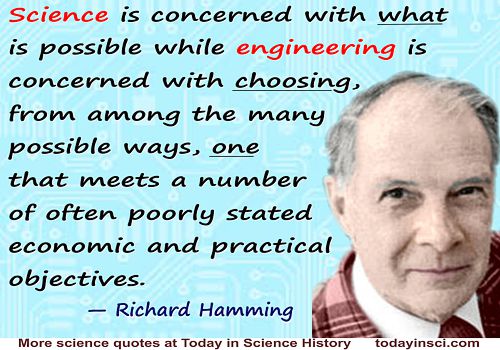
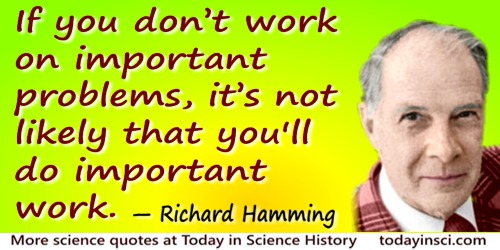

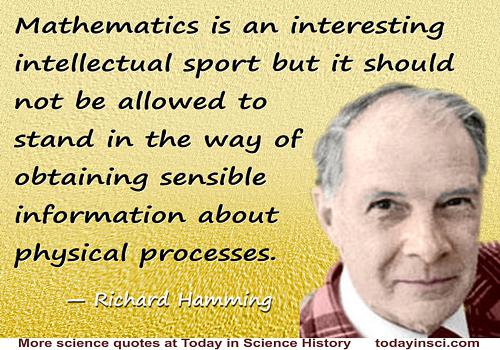
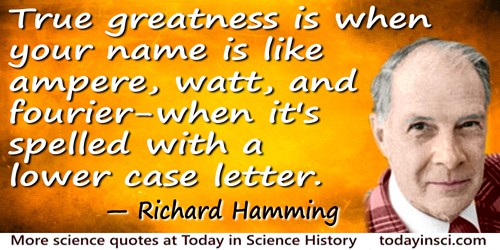
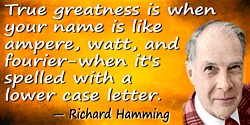
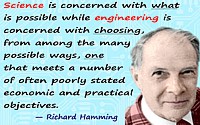
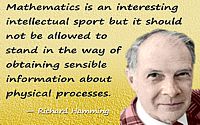
 In science it often happens that scientists say, 'You know that's a really good argument; my position is mistaken,' and then they would actually change their minds and you never hear that old view from them again. They really do it. It doesn't happen as often as it should, because scientists are human and change is sometimes painful. But it happens every day. I cannot recall the last time something like that happened in politics or religion.
(1987) --
In science it often happens that scientists say, 'You know that's a really good argument; my position is mistaken,' and then they would actually change their minds and you never hear that old view from them again. They really do it. It doesn't happen as often as it should, because scientists are human and change is sometimes painful. But it happens every day. I cannot recall the last time something like that happened in politics or religion.
(1987) -- 


